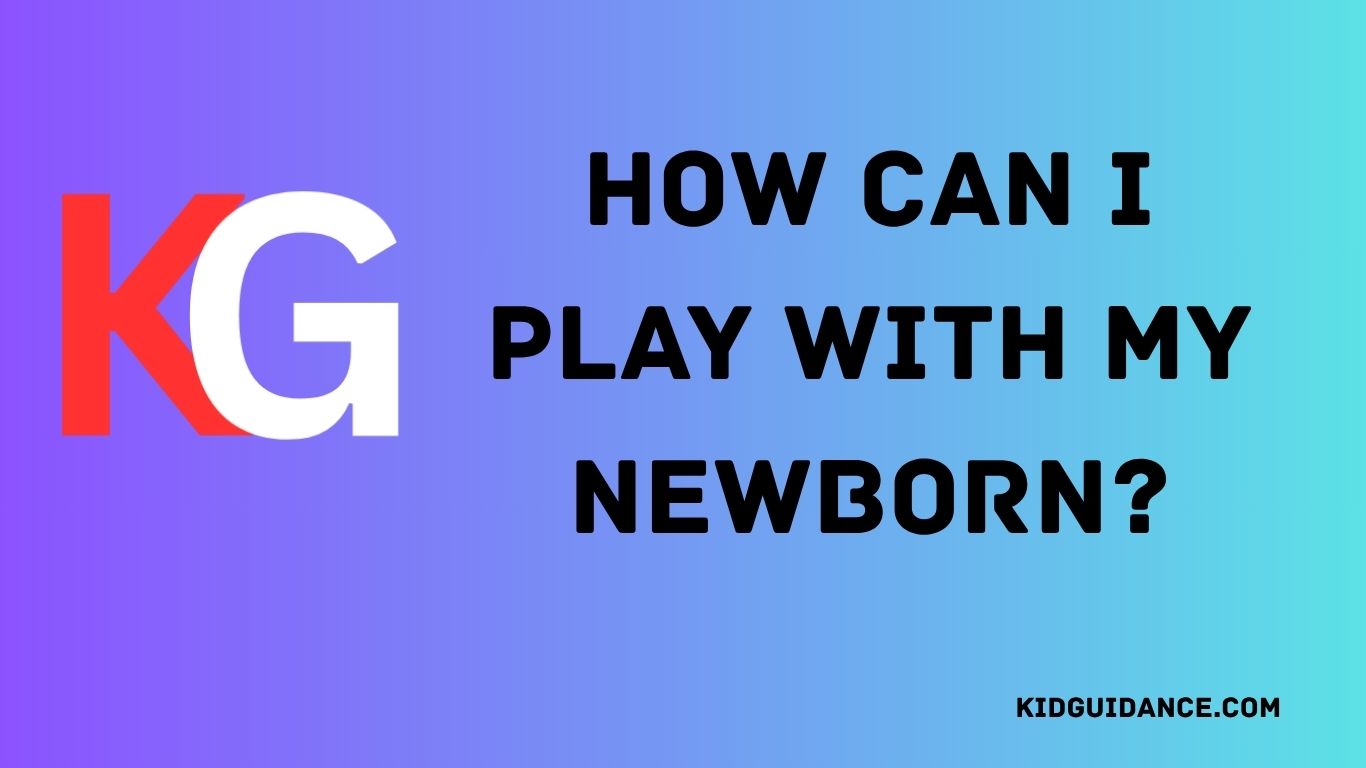As a new parent, you’re probably wondering, “How can I play with my newborn?” It might seem like they’re too tiny for traditional play, but babies are already absorbing their surroundings from day one. Playtime at this early stage isn’t just fun—it’s incredibly beneficial for their development. From fostering brain growth to strengthening your bond, every little interaction matters. In this guide, we’ll cover some simple, effective ways to engage with your newborn, starting right from birth.
When Should You Start Playing with Your Newborn?
Start from Day One
The beauty of play with a newborn is that it can start as soon as you bring your little one home. Even though newborns can’t physically play like older children, they are actively learning from their surroundings. When should you start playing with your newborn? Right away!
Early Interactions
From day one, face-to-face interactions, gentle touches, and soft sounds are the first building blocks of communication. These early moments are essential for their sensory development. Just talking to your newborn or making eye contact builds trust and a strong emotional connection.
Personal Insight:
I remember in the first few days of my baby’s life, I was surprised at how quickly she responded to my voice. It felt like she was soaking everything in, even though she was so tiny. Those first interactions are so powerful!
What Is the Best Way to Play with a Newborn?
Sensory Exploration
The best way to start playing with your newborn is by introducing them to sensory experiences that engage their developing senses.
Eye Contact and Facial Expressions
Babies are naturally drawn to faces. A simple smile, a funny face, or sticking your tongue out can captivate them. These early interactions help them learn about emotions and facial expressions, crucial for their social development.
Gentle Touches and Tummy Time
Touch is one of the first senses to develop. Gently stroke your baby’s arms, legs, and back, and include tummy time to help strengthen their muscles and improve motor skills.
High Contrast Toys
Since babies can’t see well at first, high-contrast images or black-and-white toys are easiest for them to focus on. These toys can help stimulate visual development and encourage your baby to track objects with their eyes.
Personal Insight:
I loved making silly faces for my baby during those first few weeks. Her eyes would follow mine, and you could see her reacting to each new expression, which was absolutely priceless.
The 5-8-5 Rule for Babies and Its Importance in Play
What is the 5-8-5 Rule?
The 5-8-5 rule is a simple but effective guideline to ensure your newborn doesn’t become overstimulated. It suggests 5 minutes of activity followed by 8 minutes of rest, repeating this cycle. This balance ensures that your baby gets the right amount of stimulation without becoming overtired.
Application of the Rule
Newborns can handle short bursts of activity. Start with 5 minutes of playtime (like tummy time or eye contact) and follow it with a break. This keeps the play enjoyable and safe for their little brains.
Personal Insight:
I stuck to this rule with my baby, and it made a huge difference. It allowed us to enjoy playtime without worrying about her getting too tired or fussy.
Simple Games to Play with Your Newborn
FaceTime
No, not the app! FaceTime in this case means having your baby face-to-face with you, making eye contact, and playing with facial expressions. Make silly faces, smile, or stick out your tongue to engage them.
Eye Spy
This simple game encourages visual tracking. Hold a high-contrast object about 8-12 inches from your baby’s face and move it slowly from side to side. Watch as your baby’s eyes follow the object—this helps build visual tracking skills.
Touch and Explore
To stimulate your baby’s sense of touch, use baby-safe objects with various textures like a soft plush toy, a crinkly book, or a smooth rattle. Gently place these in your baby’s hands or rub them against their skin.
Personal Insight:
Playing FaceTime with my baby was one of the most enjoyable moments. Her face lit up when I stuck out my tongue, and I could tell she was trying to copy me, which was just so fun.
How to Play with a Newborn to Promote Brain Development
Bonding Through Play
Bonding isn’t just emotional; it also supports cognitive growth. Skin-to-skin contact, talking, and singing to your baby all help stimulate brain development and language skills. Your voice is their first introduction to language, even if they don’t understand the words yet.
Language Stimulation
Talking to your newborn, even when they can’t respond, introduces them to the rhythm and flow of language. Narrate your day, sing songs, or engage in simple conversations to build a strong foundation for their language development.
Personal Insight:
I found that simply talking to my baby while doing chores or just describing what we were doing seemed to captivate her. She couldn’t understand yet, but her curiosity was evident, and I could see her trying to process the sounds.
Visual and Sensory Stimulation for Newborns
High Contrast Images
Newborns can only see blurry objects at first, so high-contrast images, like black and white patterns, are best for visual stimulation. These toys and images help your baby start to focus and track with their eyes.
Introducing Textures
The sense of touch is also critical at this stage. Using soft fabrics or baby-safe toys with varied textures helps your baby start recognizing different sensations.
Personal Insight:
Using black-and-white toys during the early months made such a difference. I could tell my baby was intrigued by the contrasting shapes, and she seemed so focused on them, which was such a rewarding experience.
Developing Social Skills Through Play
Eye Contact and Smiles
When your baby looks into your eyes and sees your smile, it strengthens social bonding. This simple interaction teaches them about emotions and social connections.
Imitation Games
Babies love to mimic sounds and facial expressions. Try copying your baby’s coos and babbles, and they’ll start to mimic you back. This is an essential part of their social development.
Personal Insight:
Once my baby started smiling back at me, I was hooked. Seeing her interact with me in those early social moments was incredibly rewarding.
The Importance of Tummy Time
What is Tummy Time?
Tummy time is essential for developing neck, shoulder, and core muscles, and it helps prevent flat head syndrome. It also prepares your baby for future milestones like rolling over, sitting, and crawling.
Tummy Time Tips
Start with short periods of tummy time, gradually increasing the duration as your baby grows stronger.
Personal Experience:
I was nervous at first, but tummy time quickly became one of the most important activities for my baby’s physical development. Watching her lift her head for the first time was such a rewarding moment.
When to Transition to More Advanced Play
Play as They Grow
As your baby reaches new milestones, their play should evolve. From tummy time to rolling, sitting, and reaching for toys, each new skill introduces new play opportunities.
Encouraging Fine Motor Skills
Once your baby starts reaching for toys, offer them items that they can grasp and manipulate. This will help develop their fine motor skills and prepare them for more interactive play.
Personal Insight:
It was amazing to watch my baby start reaching for toys. Each new milestone was like opening a new chapter in her growth.
Final Thoughts and Encouragement
Trusting Your Instincts
Every baby develops at their own pace, and playtime should feel natural. Don’t rush it—trust your instincts and enjoy these early moments with your baby.
Personal Insight:
The best part of newborn playtime is how it brings you closer. Every giggle, every smile, and every new connection felt like a step forward in our journey together.
FAQ
1: When should you start playing with your newborn?
You can start playing with your newborn right from birth. Simple activities like making eye contact, talking, and offering gentle touches help stimulate their senses and bond with them.
2: What is the best way to play with a newborn?
The best way to play with your newborn is through sensory activities like face-to-face play, gentle tummy time, and using high-contrast toys to encourage visual development.
3: What is the 5-8-5 rule for babies?
The 5-8-5 rule suggests 5 minutes of play followed by 8 minutes of rest to avoid overstimulation. This helps balance activity and rest for your newborn’s development.
4: What to do with a 2-week-old baby when awake?
With a 2-week-old, you can engage in tummy time, make eye contact, and gently stroke their skin. These activities help develop their muscles and sensory awareness.
5: How can I stimulate my newborn’s brain?
Stimulate your newborn’s brain by talking to them, singing, making funny faces, and providing tactile experiences like gentle touches and high-contrast visuals.
6: What are the benefits of tummy time for newborns?
Tummy time helps develop neck, shoulder, and core muscles, which are essential for milestones like rolling over, sitting up, and eventually crawling.
7: How long should I play with my newborn each day?
Newborns can handle short play sessions of 5-10 minutes. Gradually increase playtime as they grow, ensuring they get enough rest in between activities.
8: Can playing with my newborn help with their emotional development?
Yes! Simple activities like eye contact, smiling, and mimicking your baby’s expressions help them understand emotions, laying the foundation for emotional intelligence.
9: How can I make tummy time fun for my newborn?
Make tummy time enjoyable by engaging with your baby. Use toys to capture their attention and make funny sounds or faces to keep them entertained during the activity.
10: When should I start using sign language with my newborn?
You can start introducing simple signs around 5 weeks. It helps your newborn communicate before they can speak, reducing frustration and fostering early language skills.




